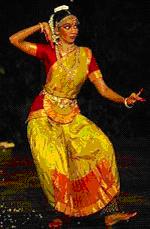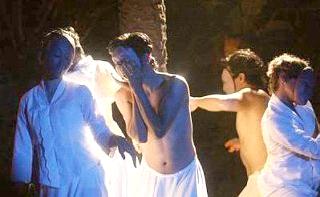Kuilenga is a full-length production by the Baker & Tarpaga Dance Project (BT Dance Project), a contemporary dance company directed by Esther Baker-Tarpaga and Olivier Tarpaga. The husband and wife team founded the intercultural company in 2004 and they are based in Los Angeles, California and Ouagadougou, Burkina Faso.
 Olivier Tarpaga and Esther Baker-Tarpaga
Olivier Tarpaga and Esther Baker-Tarpaga
But due to stage limitations at the experimental theatre, the couple presented only one segment of the full-length that addresses themes of love, immigration, displacement, and the physical boundaries between violence and peace.
Kuilenga, according to Esther and Olivier, is a reflection of their lives as they travel from place to place. While the dance is about how they move across time and space, it is also about the lives and movements of other people. This contemporary dance also drew movement vocabulary from West African traditional dances such Gourmantche (a dance from an ethnic group in Burkina Faso) and Sabar (danced to Sabar drums from Senegal).
The dance began with two still figures on stage. One remained still, while the other started twitching his upper body, exploring limb after limb before working himself up into a convulsion (movements from Gourmantche). The sudden explosion of drums after a period of silence signalled the first signs of body contact where the couple took turns to roll over each other’s back.
The dancers used the energies of “push” and “resistance” in actions that seemed like wild animals butting heads and people fighting each other. The message was that fights are futile and doesn’t get anyone anywhere, since spatially the dancers did not move.
Fighting done, they moved away from each other in gliding and sweeping movements across the floor. After moving one full circle, the dancers came together and locked themselves in embrace. It was only after this “kiss-and-make-up” scene that we saw the dancers share similar movements - sometimes in unison and sometimes one after the other.
Then, in full display of their individuality and identity, they each broke into a variety of West African dances bringing exciting, dynamic, and rhythmic energy to the stage. When the “this-is-me” statement was done, they walked off stage hand-in-hand with their back towards us, in a sweet, happy ending.
The couple were also in ASWARA to give a weeklong workshop, which the participants, comprised of drummers and dancers, at the end of it, showcased what they’ve learnt - Diansa (celebration dance) and Mandiani (fast dance for young girls). ASWARA students and graduates make up most of the dance participants while the drummers comprised of ASWARA students, guest performers Tony Tang (percussion teacher from Sri Cempaka) and teen Andrew Kam (child prodigy listed in the Malaysia Book of Records for passing his Grade 8 percussion exams at the age of nine).
It was a carnival when the students burst forth on stage singing, clapping, and dancing to the rhythms of the live drum ensemble led by Olivier on the djembe (a drum from Burkina Faso). It made me think what a great youth program this would make when I observed how much the kids were enjoying themselves. All those excess energy that the youths have were poured out on stage. The dance combinations were simple and easy to learn; but that makes the dance accessible to everyone, even those who are not trained in dance.
“I never expected the students to be so good at it,” said Olivier, “because this is a culture totally different from theirs. But they just went all out and enjoyed themselves! Judging from the response of this workshop, we will definitely make plans for more.”
***
Contemporary Dance in West Africa
According to Olivier, the contemporary dance movement in Africa began in the '80s and the leading proponents of this genre are his teachers, Salia Sanou and Seydou Boro.
“At first, the people in Africa did not understand contemporary dance because it suggests a different way of expression. In our tradition, we burst forth with energy and go all out to express ourselves. But in contemporary dance, we play with different levels of energy. The people were afraid that it would hurt their tradition.”
“But now, people realize that contemporary dance does not hurt our tradition, but in fact, complements it. The contemporary dance scene is blooming in Burkina Faso. Every two years, we hold the Choreographic Encounter of Africa and Indian Ocean where 11 pre-selected dance companies compete against each other. The winner will get financial support and will be toured worldwide. Other developments include the building of the first Centre for Choreographic Development in Burkina Faso.”

